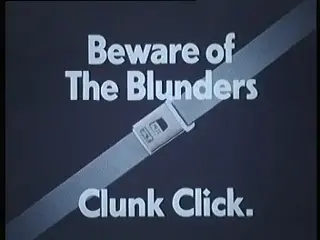40 YEARS OF COMPULSORY SEAT BELT WEARING
31 January 2023
Forty years ago today, the BBC broadcast this footage of motorists remembering – or not – to obey the new seat belt regulations -
A Peugeot 504 owner is following the rules, but a Mini driver with a Paul Calf moustache has clearly forgotten that he is now liable for a £50 fine, despite the Department of Transport’s £680,000 publicity campaign.
In 1982 Kangol established a chain of National Seatbelt Fitting Centres in preparation for the new law, which came into force on the 31st of January, 1983. It applied to all post-1964 cars, all post-1966 vans and all post-1969 three-wheelers. Drivers were responsible for front-seat passengers under 14, but the legislation did not apply to the back seat. Rear safety belts were still not standard equipment on all new cars.
At that time, belt-wearing had been the subject of debate for over a quarter of a century. As far back as 1957, Kenning would sell you their Type D ‘Swaystop’ (in tartan) for just 30 shillings. At that time, the impact of safety tests in the USA was already impacting across the Atlantic. By 1959 the British Safety Council recommended establishing a committee to advise the government of “the pressing need for universal adoption of seat belts in this country.”
In that same year, an article in The Tatler stated: “The facts are known; we need a propaganda effort to make vehicle-users act on them, similar to that which persuaded motor cyclists to use crash helmets.” The BSC also urged for educational campaigns, and their report included an account from the Duke of Richmond and Gordon, the owner of the Goodwood racing circuit. When travelling on the A3, his car collided with a tractor. “On coming to rest in the offside ditch my wife and I both marvelled at our escape, and have since congratulated ourselves that we got strap-minded when we did.”
The Sunday Dispatch ran a campaign for all British cars to be so equipped, and on the 27th of November 1959, they proudly announced the Queen’s cars were to be fitted with belts. However, earlier that year, The Daily Telegraph noted, “In Britain there has so far been little interest in safety belts,” although “some car makers are beginning to offer them as optional equipment.”

1960 saw the debut of the first British car with seat belts as standard equipment for a range of ‘safety’ fittings, including a fire extinguisher and a first-aid kit. However, at £3,102 (six times the price of a Mini), the Jensen 541S was unlikely to be a common sight. Bolt-points for safety harnesses were not unusual features on popular family saloons in the early sixties, but on the 24th of May 1962, The Guardian pointed out their lack of popularity. “Whereas in Sweden about 60 per cent of all cars are fitted with safety belts, in Britain the proportion must be less than one in ten.”
One major challenge facing the government was too many drivers who regarded themselves as the Graham Hill of East Cheam, and the February 1964 edition of Motor Sport featured this editorial comment:
“I do not deny that lives and limbs have been preserved by safety-belts. But I do not use them in my car for the same reason that I do not take a parachute when I fly in a private or commercial aeroplane. Nor do I strap myself in bed, stand up with my arms outstretched in a railway carriage or sit with a Pyrene in my lap in front of the fire.”
The scribe added in Terry-Thomas-like tones, “N.B. – I do believe in seat belts for sleepy passengers and all girl-friends.”
Nevertheless, the UK’s first legal requirement for seat belts came into force with the passing of the Motor Vehicles (Construction and Use) Regulations 1966. This required anchorage points in all new vehicles and subsequent amendments included fitting three-point belts in 1967 and in 1968, their retro-fitting to post-1965 cars. To convey that belt-wearing should be an essential part of motoring, the Central Office of Information produced a series of increasingly graphic short films.
Such public information films - or PIFs - were shaped by the advent of ITV in 1955. The popularity of commercial television led to the COI adopting the same techniques as advertisements for soap powder or Strand cigarettes, delivering their message in under a minute. Many readers will recall the infamous Beware of The Blunders series from the late 1970s.
Inevitably, the family of Britain’s worst motorists drove an ADO16 – the car of doom for any self-respecting PIF.
And so the 31st of January 1983 marked a turning point in British motoring history, even if not all drivers approved of the new rules. On the 26th of February, a leading broadsheet published a letter entitled “Heroes Don’t Need Seat Belts” that I am convinced was written by either Sir at Rawlinson End or Rowley Birkin QC. It concluded: “My family will not be voting Conservative until this seat belt legislation is revoked, but in the meantime, I shall, of course, continue to read my Daily Telegraph.” Standards., old boy…
